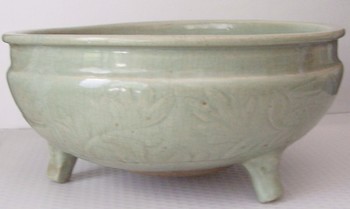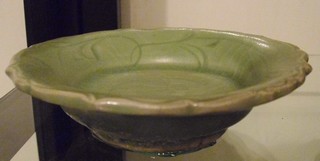Longquan Celadon and Kilns
With monochrome porcelain like Longquan celadon it is usually the glaze that is appreciated.
Longquan kilns
were not the earliest to fire celadon wares. Celadon was produced in China since at
least the 3rd century (the Three Kingdom Period). However the Longquan kiln system was one of the largest kilns systems, consisting of many individual kilns numbering in the hundreds, that covered a vast area.
The original Longquan kiln
was founded during the Song dynasty in the area of todays Zhejiang province. It was one of the eight great kiln
systems of ancient China.
It has a second name, namely Di kiln, "Di"
meaning younger brother as there was also a Ge kiln ("Ge" means older
brother), but the Di kiln is better known by the name of its location,
Longquan (or Long-Quan).
 |
Longquan censer |
The Longquan kiln or kiln system was at its zenith during the Southern Song dynasty (1127-1279).
In
the Yuan dynasty (1206-1367) celadon production in China was generally
on a decline as the Mongolian ruling class preferred the blue and white,
and polychrome porcelain of Jingdezhen.
Paradoxically, at a time when other celadon kilns experienced a downward turn, the southern Longquan kilns experienced an upturn
instead; that was due to an increase of orders from abroad. Thus the kiln continued producing until far into the Ming dynasty. Celadons of
the Yuan dynasty generally do have a thick glaze. In the Ming dynasty the
glaze of Longquan glazes became thinner and attained a slightly yellowish tint.
But then, in the middle of the Ming dynasty even production of Longquan kilns began to decline.
As the kilns had ceased production, any items produced later, e.g. in the Qing dynasty, are basically imitations of Longquan wares.
|
Being one of the eight great kiln systems of the Song dynasty, a large number of kilns in and around the Longquan area produced celadon. Over 500 individual kiln sites have been identified so far, indicating that Longquan was an extraordinarily extensive kiln system. |
Shallow Longquan celadon bowl  |
Features of Longquan Celadon
- Many Longquan items have a not-so-transparent glaze, which has
virtually no transparency. One cause is
its thickness. A recently measured glaze
along the break of a Longquan plate showed at the thinnest spot a
thickness of approx. 0.5mm, most of the rest was approx. 1mm - very thick
for a glaze!
Unlike other glazes the Longquan glazes was obtained by application of multiple layers of glaze, building it up to its extraordinary thickness. - With Ming Longquan items all glazed edges, top rim, any edges or ridges of impressed or carved decorations,
etc. should be lighter in color than the other surfaces. These areas show as
yellowish or light green edges/lines.
The reason for this is twofold. The clay body of Longquan ceramics was formed by pressing it into molds. The resulting ridges of the clay body had fairly sharp edges, which resulted in a thinner glaze in these places, with the corresponding lighter color. At the same time the glaze was generally thinner in the Ming dynasty. Conversely, incised floral designs and recessions may appear darker on such items, due the accumulation of the glaze in the recesses of such decorations
What is stated above is primarily valid for the lighter colored Longquan celadons of the Ming dynasty, which had a relatively thin glaze. Song/Yuan dynasty Longquan celadons do not show this so pronounced, due to the thickness of the applied celadon glaze. - Longquan celadons were made in the Song, Yuan and Ming
dynasties. In the late Yuan and the Ming dynasties the glaze generally
had a more yellowish green color than earlier. The best glaze color is
possibly the green of the Song dynasty. (In Chinese this is called "plum
green" - the color of an unripe plum.)
- Any Longquan-like items made in the Qing dynasty are not real Longquan wares, as the production at the Longquan kilns ceased during the Ming dynasty. They are copies of Longquan wares made at kilns in Jingdezhen and in other places. Their glaze may look the same, but Qing dynasty copies are often recognizable by their different foot rim.
